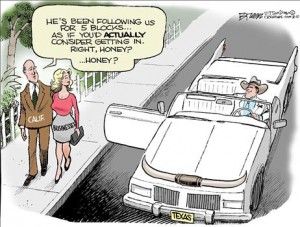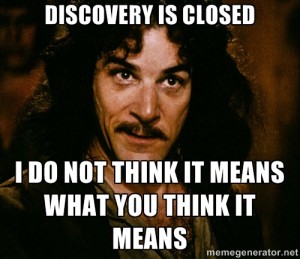California Drives Away Toyota Jobs
THIS IS WHY WE CAN’T HAVE NICE THINGS.
It looks like California is losing about 3000 jobs, as Toyota recently announced that it plans to move its headquarters from Torrance, California to Plano, Texas.
Although some 2000 jobs will remain (for now), a lot more are trading in their marijuana and grapes for 10-gallon hats and guns. Yee Haw!
What could possibly have prompted Toyota to move from California to Texas? Well, your humble blogger’s understanding is that the cost of doing business may have had something to do with it.
For example, in 2010, the average premium paid in workers’ compensation insurance in California for every $100 in payroll was $2.29. So, on average, an employee making $40,000 per year cost $928 per year just in workers’ compensation premiums. By contrast, in 2009, Texas had a subscriber premium of $1.47 for every $100 of payroll. That same employee, earning $40,000 per year, would only cost a Texas employer $588, or almost half.
So, by moving to Texas, Toyota could expect to save $2,460 for every $100 in payroll for those 3000 jobs. If we were to assume that the average Toyota job moving to Texas will be offering $40,000 in annual payroll, Toyota moves to save around $1,000,000 per year in workers’ compensation premiums alone.
That doesn’t factor in that Toyota will have the option to opt out in Texas, nor do those numbers reflect that California’s costs have gone up while Texas continues to be more affordable.
Mind you, again, dear readers, that the cool million dollars is for workers’ compensation premiums alone, and not the host of other fees, taxes, licenses, lawsuits, and other schemes, graft, and harassment Toyota can look forward to avoiding by fleeing California.
Now, don’t get me wrong – I love it here in California. I love the weather, I love the food, and I love a good portion of the people, excluding that sizeable and significant minority – the lawyers.
But we’ve got to get this thing fixed. Toyota is not the first business to leave and it certainly won’t be the last, and California’s workers’ compensation system, much like the pantheon of regulations and liabilities for employers big and small, are slowly but surely strangling us.
Accordingly, the most effective route of this mess is to gather up all the members of California’s Legislature, and organize a field trip to a sheep farm. There, the farmer can demonstrate to California’s elected representatives, that you can sheer a sheep many times, but only skin it once. California needs less leather and more wool.

